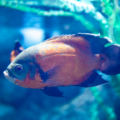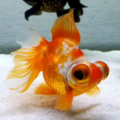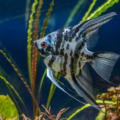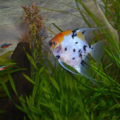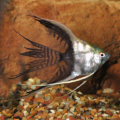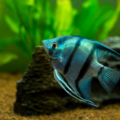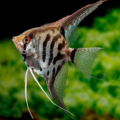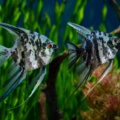The best care guide with essential insights on maintaining the Smokey Angelfish. Extra tips on origins and physical traits for better insight.
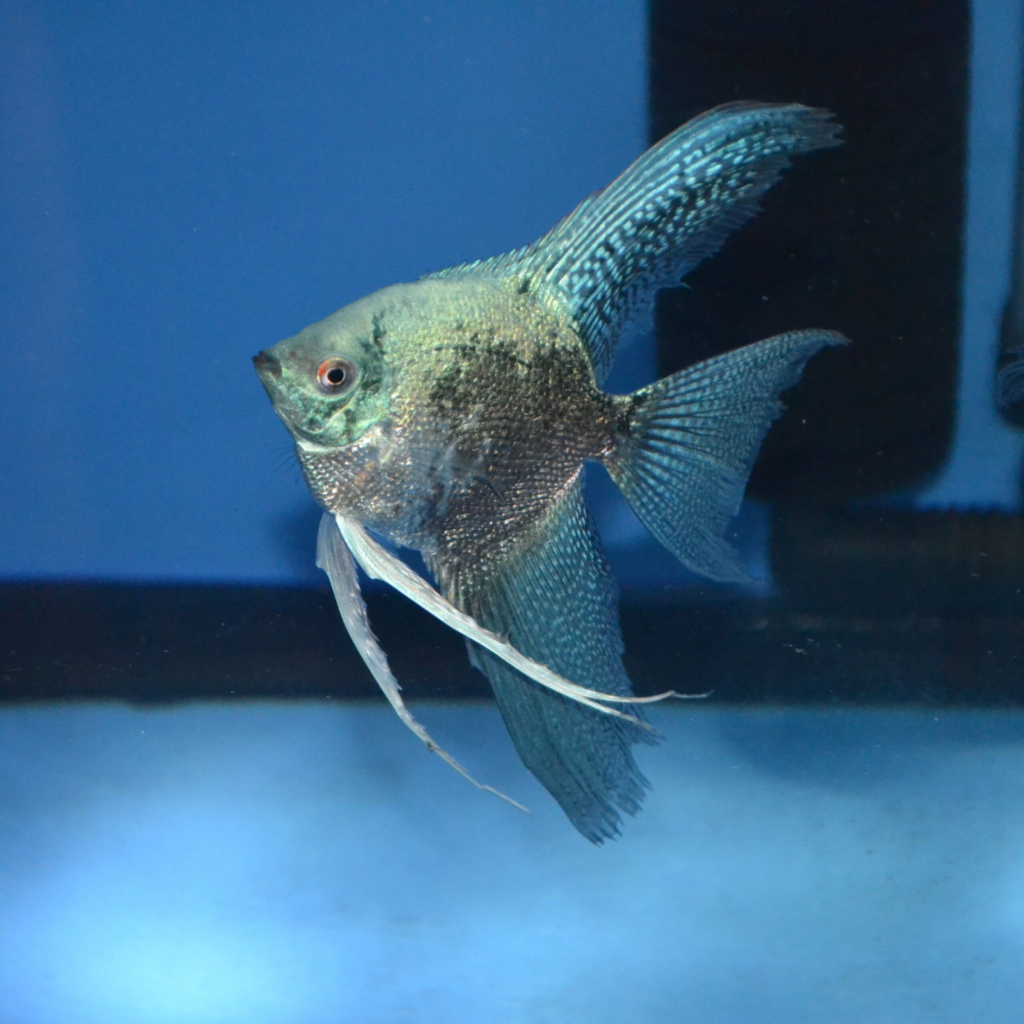
Exploring the Smokey Angelfish
Do you want a distinctive and captivating aquarium fish in your community tank? Have you considered choosing the Smokey Angelfish species, or is this your first time hearing about it? If yes to both, don’t worry. You’ll get all your answers today.
Despite being a uniquely colored angelfish with dusky gray skin, the Smokey Angelfish is a worthy addition to any tank. It’s one of the most desirable Angelfish varieties because of its misty look, elongated fins, and interactive nature.
If you want to know why many aquarium enthusiasts choose this species even though it’s one of the lowkey variants of the freshwater angelfish, keep reading.
Origins and Breeding Background
Like many ornamental aquarium fish, the Smokey Angelfish’s origins go back to the late 20th century when fish traders used new breeding techniques to create unique colored and shaped species.
Their experiments led to several genetic developments, including the birth of the Smokey Angelfish. One of the selective breeding outcomes of this interesting variant was that it retained its hardy nature while producing a new skin tone.
These lineage insights are necessary to help you understand your new pet’s care needs.
Distinctive Physical Features
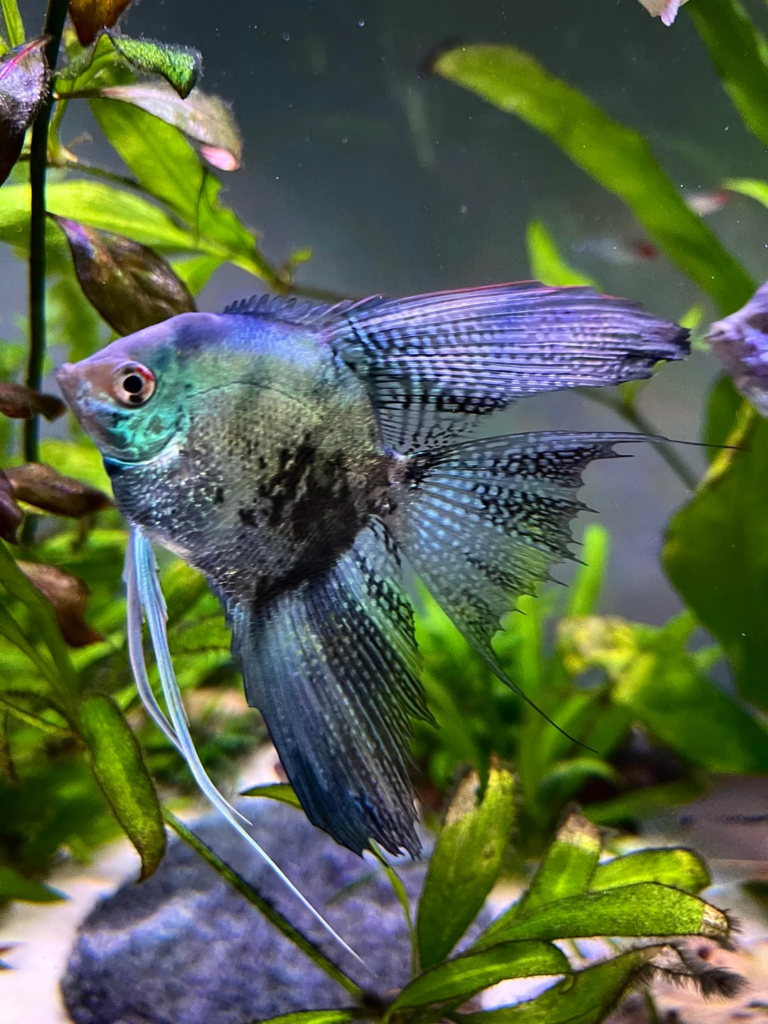
A closer look at the Smokey Angelfish appearance shows you that despite having the same triangular body as its canon parents, there are more distinctive features in its body structure and coloration.
On the surface, the unique coloration is a smoky gray, but there’s more. This species’ dusky tone can be light or dark, almost charcoal, depending on its age, health, and environment. It also sometimes has bluish fins earning it the nickname Blue Smokey Angelfish.
The Smokey Angelfish body configuration is the same as the natural freshwater angelfish. It’s triangular and grows up to 6 – 8 inches in adulthood with long, flowing, dorsal, anal, and pectoral fins.
However, they have aesthetic fish traits, such as territoriality, aggression, and dominance, that make them complex tankmates. You’ll learn more about integrating this species soon, but for now, let’s discuss the care guidelines.
Specialized Care Guidelines
Because this species is an ornamental variant borne out of selective breeding techniques, caring for Smokey Angelfish requires special practices. You must integrate regular angelfish care practices with specialized ones that accommodate their uniqueness.
Follow these guidelines to get the best out of your Smokey Angelfish:
Optimal Tank Conditions
The ideal tank size for the Smokey Angelfish is a tall design that holds up to 30 gallons of water for a small group. You can increase the size by ten more gallons per new fish you add to the tank.
Water Parameters
Maintaining angelfish health starts with giving them a home as close to their natural habitat as possible. Keep the water slightly acidic to neutral with a pH level of 6 – 7.5, a cool temperature range of 76 – 82℉, and hardiness should be soft or moderately hard.
Maintenance Routines
You must also invest in aquarium maintenance if you want to stabilize those water parameters. Change 20 – 30 of the water weekly to rid it of unprocessed waste or bacteria growing in stagnancy.
Get a test kit to ensure the water parameters are always within optimal levels. Once you’ve settled on the water parameters and tank size, it’s time to design your tank.
Creating the Ideal Environment

Your Smokey Angelfish tank setup should be a miniature of the South American Amazon Basin, as much as possible. Creating a similar environment to the natural habitat helps you maintain your pet’s mental and physical health.
Here is how you can recreate the ideal angelfish habitat without breaking the bank —
Substrate
Start decorating from your tank’s base. Use fine sand, smooth pebbles, or fine gravel and granite. These smooth substrates ensure your pets always get a soft landing when they dive to the bottom.
Decor
Build on your substrate by adding more soft decor and getting creative. Use plants, driftwood, and rocks to build caves and hiding spots for your Smokey Angelfish. They get bored of socializing sometimes and need their solitude.
Lighting
Because this species has a dusky tone, they love camouflaging. So, use moderate to dim lighting on a 12-hour cycle in the tank. It’ll give your pets a natural night-to-day routine while allowing them to maintain their anonymity at will.
Filtration
Add effective filtration to the tank to boost the nitrogen cycle and convert harmful waste to beneficial bacteria. Ensure it has a regulator so you can set it to a moderate flow of slow-moving waters.
Tank Mates
Your final step in creating the ideal angelfish habitat is adding the best tank mates or leaving your Smokey Angelfish alone. From the beginning, you must’ve made your choice based on your tank size.
So, if you want to build a community tank, your aquarium should hold at least 55 gallons of water. Keep reading for the best tips on integrating the Smokey Angelfish, but first, let’s discuss nutrition and feeding.
Nutrition and Feeding Practices

The Smokey Angelfish diet requires a holistic approach because you’re catering to their mental and physical health and potential breeding. I’ve split this section into two for a clearer understanding — Nutritional Needs and Feeding Practices:
Nutritional Needs
Smokey Angelfish eat a variety of foods ranging from plant matter to live foods. If you care about their physical appearance, then focus on enhancing color through diet. Feed your pets with food high in carotenoids like spirulina to give them a deeper gray tone.
But if you’re okay with light gray Smokey Angelfish, then focus on high-quality flake foods, pellets, freeze-dried food, frozen or live food like Daphnia and Bloodworms.
For more on feeding your aquatic pets check out The Ultimate Guide to Fish Food: Pros and Cons & Best Choices!
Feeding Practices
Although you want to feed your pets with a balanced diet, you mustn’t overfeed them. Always practice portion control by feeding your Smokey Angelfish only twice to three times daily. Give them only little amounts of food that they will finish in less than 3 minutes.
Failure to stick to these feeding practices leads to overfeeding and excess waste. They can also get health diseases like obesity or stress, which cause even bigger health issues.
If that happens despite practicing the best feeding and nutrition practices, don’t worry. There are solutions.
Health Care and Disease Management
If you’ve followed this guide to this point, you already have the best disease prevention tips. Here’s a reminder if you’ve forgotten:
- Practice specialized care
- Build the ideal tank
- Maintain a balanced diet
Unfortunately, preventive health care, while the most effective solution to common ailments, doesn’t always keep pets safe. Genetic predispositions or careless practices may lead to health complications ranging from mild to severe.
Here are some of them and how to handle them —
White Spots
Symptoms: Grainy white spots on skin and gills.
Cause: Bacterial infection.
Treatment: Copper-based or Heat treatment to speed up the bacteria’s life cycle.
For more details checkout our article on How to Treat Ich Outbreaks in Your Freshwater Fish!
Fin Rot
Symptoms: Fraying fins, Discoloration, and any other damage on the fins.
Cause: Poor water quality breeding bacteria.
Treatment: Antibacterial treatments and water changes.
Velvet Disease
Symptoms: Dusty skin.
Cause: Fungal Infection.
Treatment: Copper-based medication or Formalin.
Observe your existing pets for signs of stress, discomfort, or physical changes.
For the best health management, new fish should always be quarantined before being introduced to the community tank. To observe them and prevent the spread of any illnesses they may carry, check out these breeding tips.
Breeding Smokey Angelfish

Successful breeding practices for Smokey Angelfish start from the breeding tank to how you care for the Fry before reintroducing them to the main tank. If you miss one step, you risk ruining the entire process.
So, read these next guidelines carefully for the best reproduction techniques.
Breeding Tank
Use a separate tall tank that holds at least 40 – 55 gallons of water, depending on the sizes of your adult Smokey Angelfish. Maintain the same water parameters except for the temperature, which shouldn’t exceed 78–80℉.
Add a flat surface like a ceramic saucer or a spawning mop to the substrate, preferably under the cave or any covered area. Then, feed your breeders with a high-quality breeding diet to prepare their bodies for spawning.
Breeding Pair
This video has been very helpful in identifying the sex of angelfish, I highly recommend it:
Remember that the Smokey Angelfish is a product of careful selective breeding. So, you must continue genetic preservation in breeding if you want the exact variant.
The slightest mistake can give you a different kind of Smokey Angelfish, and you may become the founder of a new species.
You may observe your adult male and female Smokey Angelfish for natural bonding pairs or choose them based on preferable traits.
Spawning
Once you’ve selected your pair and placed them in the breeding tank, the male will chase the female until it nudges her belly to lay eggs. She’ll lay the eggs on the flat surface, and the male Smokey Angelfish will fertilize them.
Within 2 – 3 days, the eggs will hatch into larvae. At the larvae stage, they feed on their yolk sac for survival before growing into Fry within 4 – 6 days.
Fry Care
Caring for Angelfish fry isn’t complex, but it requires dedication. You must change their food to infusoria, crushed powdered flakes, and pellets specifically made for Fry, and separate their parents from the tank.
Within 4 – 6 days, they’ll grow larger and develop mouths for chewing more solid foods. Don’t rush the feeding, but ensure they have adequate nutrition. As they grow, separate the larger Fry from the smaller ones to prevent predation.
Reintegration
Quarantine the young adult Smokey Angelfish in a grow-out tank and observe them for a few days before integrating them into the main tank. This is the best method for disease prevention and successful breeding.
It’s time to review the best method for selecting compatible tank mates for your Smokey Angelfish. You must first consider its temperament and then its physical traits.
Because the Smokey Angelfish is territorial, aggressive, and loves dominating its habitat, you must ensure that your community tank dynamics don’t threaten their nature. Keep them with same-sized species with bold but not dominant personalities that can compete with their dominance.
If you want to watch social interactions among aquarium fish, ensure you pick a peaceful community. The most compatible pairs for your Smokey Angelfish are Corydoras, tetras, and Rainbowfish.
When integrating your Smokey Angelfish into the community tank, start gradually. Also, ensure the environment has enough hiding spots for them to hide when they feel overwhelmed.

Conclusion
That’s everything you need to know about Smokey Angelfish Care. If you care about enriching your aquarium with freshwater fish for aesthetic appeal and interaction with humans, you’ve got the right one.
Don’t be in a hurry, though. Remember the physical traits of this unique species and its specialized care needs. If you can’t dedicate time and money to its care, then find a lower-maintenance fish for your tank. But if you’re ready to put in the work, welcome to the family!
Feel free to share your Angelfish care achievements with other aquarium enthusiasts. I’d love to see how you’ll bring this guideline to life.

